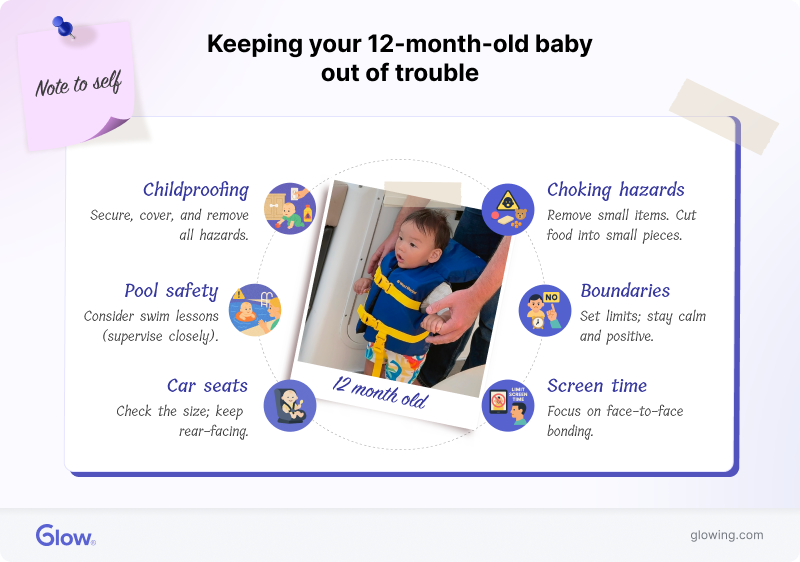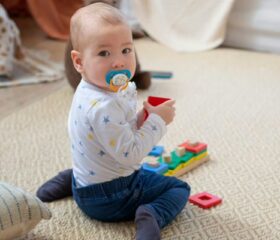Baby Month by Month
12-Month-Old Baby
Your baby may take her very first steps this month!

Your baby is well along the road to becoming one of the big kids. With that comes her literal first steps toward exploring the broader world beyond your arms.
From physical and behavioral milestones to some much-needed baby-proofing steps, here’s what awaits you as your baby turns 12 months old.
Your baby’s development at 12 months old
At 12 months, many babies’ growth rates slow down a little, while other babies go through a growth spurt around this time. Either way, you’ll still see big changes from month to month.
The average 12-month-old boy tips the scale at around 21 pounds, while girls weigh slightly less, at under 20 pounds. 1 Boys average about 30 inches in height, and girls average about 29.5 inches. 2
Your pediatrician will track your baby via a growth chart, and as long as she follows her curve, you shouldn’t lose sleep over where she falls within the averages.
Your baby’s physical development
Lace up your sneakers, because your baby is about to get very mobile. Expect both exciting and exhausting times ahead with a big leap in her physical abilities this month, as many 12-month-olds are:
- Cruising: She’ll use whatever she can get her hands around to prop herself up and try to walk. That includes you, so lend a hand to help build her confidence and balance.
- Standing: Many 12-month-olds can stand alone briefly without support. Of course, your baby will wobble a bit, but those chubby legs are getting stronger from the effort. 3
- Taking first steps: The longest journey starts with a single step, and your baby’s first birthday often marks that first stride toward independence. If she chooses to lounge a little bit longer, however, don’t worry. Most babies start walking between 9 and 18 months. 4
- Crawling and scooting: While you’re waiting for your baby to put her best foot forward—literally!—she’s still developing her muscles and coordination skills by crawling or scooting.
No matter how your 12-month-old gets around, you can be sure she’s moving with purpose. Do your part to give her safe opportunities to explore, coupled with lots of cuddles and cheers for reassurance.
Your baby’s fine motor skills and exploration
While your baby’s big movements are exciting, the small victories count just as much. At 12 months old, she’s honing her fine motor skills to master her environment. Here’s a snapshot of some things you’ll see her doing:
- Pincer grasp: Your baby’s refined pincer grasp (using her thumb and forefinger) allows her to scoop up objects like finger foods more easily. 5
- Object manipulation: You won’t be able to stop your baby from twisting, turning, pushing, and pulling everything in her path. Humor your mini-cyclone with a variety of toys that encourage these skills.
- Scribbling: Stock up on crayons and chalk for her to experiment with. Not only will your refrigerator door appreciate her masterpieces, but you can also take pride in knowing your baby is building the foundations for her eventual writing skills.
- Stacking: Blocks are great at this age for stacking and knocking down, with the main benefit being better hand-eye coordination and spatial awareness.
- Page-turning: Who needs an iPad when you have books? Encourage tactile page-turning to help train a future bookworm.
Your baby’s communication skills
Though there’s still a way to go before you can have a full conversation with your baby (toddlerhood is usually when babies start really talking), your little one’s communication skills are rapidly expanding every day. Here’s what you’ll see:
- First words: You’ll notice a few recognizable words, like “mama,” “dada,” or the names of other important people in her life. 6
- Understanding: Your baby understands more than she can express and can understand simple one-step commands, like “pick up the ball” or “look at the dog.” Whether she’ll always follow them is another matter entirely.
- Pointing and gestures: Expect a lot of finger-pointing and head-shaking to communicate her wants and needs. She won’t hesitate to direct you to the kitchen when she’s hungry or point to a toy on a shelf.
How to support your baby’s language development
Describe what you’re doing and what your baby sees as you both go about your day. Name objects, body parts, and people, and create simple songs and rhymes to keep the lessons entertaining and memorable. When she “talks,” encourage her by talking back and showing you understand her intentions.
With every adorable babble, grunt, and arm wave, your baby will become a master at having “conversations” without many words.
Feeding your 12-month-old: expanding palates
Welcome to the wonderful world of mealtime with a one-year-old. Though your baby has already been eating solid food for a few months, things are getting more interesting. Here’s where the once-standard purees and formula slowly give way to a more varied and exciting diet:
- Meals and snacks: You’ll see your baby now eating three meals and two snacks daily.
- Finger foods: As your baby gets more control over those fine motor skills, she’ll get comfortable feeding herself finger foods.
- Whole milk: This is the age when babies can drink cow’s milk. You can slowly introduce whole milk into your baby’s diet by adding a few ounces (about 16–20 ounces daily) to her formula or breastmilk at each feeding. Since whole milk’s extra fat is important for brain development, ask your pediatrician before switching to reduced-fat (2%) milk. 7
- Variety is key: Keep your baby’s plate interesting. Help her develop a love for a wide range of flavors and textures with healthy options from different food groups.
- Portion sizes: Your baby is getting bigger, but keep her portions small. About a quarter to half cup of each food group at each meal will do the trick. 8
- Listen to her cues: Don’t force a clean plate. 1-year-olds know when they’re full, so if your baby stops eating, she’s had enough.
- Playing with food is normal: Squishing, smearing, and dropping food is all part of exploring. Set gentle limits on the mess, but don’t freak out if everything doesn’t make it into your baby’s mouth.
Expect your baby’s appetite to change from day to day. Focus on serving up healthy choices and making mealtime a positive experience for you both.
Your baby’s sleep at 12 months old
Sleep is still a big priority for your 12-month-old. She’ll easily clock in around 11–14 hours of sleep. While most babies start sleeping through the night for much longer stretches at this age, she may still need a couple of naps throughout the day. Here’s what to expect: 9
- Nap schedule: The length and frequency of your baby’s naps will keep you on your toes. Some babies will take two consistent naps, while others transition to one longer nap around this time.
- Bedtime routine: Create a consistent bedtime routine. You can’t go wrong with a bath, a book, a song, and a hug.
- Falling asleep independently: To help your baby learn to fall asleep on her own, try laying her down when she’s tired but still awake.
Don’t feel rushed to move your toddler into a bed. Many parents hang on to the crib until their little one is potty-trained (babies don’t start showing signs of readiness for potty training until they’re around 18–24 months, which is when they develop bladder and bowel control). 10
Chat with your pediatrician if you have any nagging concerns or questions about your baby’s sleep patterns, or if you aren’t sure what steps it’s appropriate for you to take at the one-year mark.
What to know about sleep regressions
If your once sound sleeping baby has started to battle bedtime at 12 months old, chances are that she’s going through a sleep regression.
Unfortunately, many kids experience a sleep regression at 12 months old, when they’re much more physically active and engaged with the world around them. 9
If it happens, you’ll need to persevere. The good news is that sleep regressions are usually temporary. In the meantime, focus on maintaining a consistent bedtime routine. However, if you’re struggling to get your baby to sleep, you can always reach out to your doctor or a sleep specialist.
Your baby’s health and safety at 12 months old
Health and safety should remain your top priorities at 12 months, especially with your baby so eager to ram around and explore.
The 1-year checkup
It’s time for your baby’s 1-year well-child visit. Your pediatrician will perform a physical exam to check your baby’s health. This includes checking every curve on your baby’s growth chart and performing a quick blood test via finger prick to check for anemia and lead levels.
This well-child visit also brings another round of vaccinations, which could include the following: 11
- MMR vaccine: This vaccine protects against measles, mumps, and rubella, all highly contagious diseases. The first dose happens between 12 and 15 months.
- Hepatitis A vaccine: This vaccine guards against a contagious liver infection. Your baby will receive the first dose between 12 and 23 months.
- Varicella vaccine: This vaccine prevents chickenpox, the common name for varicella. Expect the first dose between 12 and 15 months.
As always, feel free to bring your stack of questions and concerns to your pediatrician.
Common health concerns at 12 months
While vaccines will protect your baby from some of the more serious diseases out there, she’s bound to get a little under the weather occasionally. Here are some of the common health concerns that pop up at 12 months:
- Diarrhea and constipation: Digestive problems like diarrhea or constipation can piggyback on your baby’s diet transition. Your doctor can give you some tips on how to keep everything flowing smoothly. 12
- Allergies: New foods also risk exposing allergies, so look for indicators such as hives, wheezing, or vomiting. 13
- Colds and infections: As your baby gets more curious, she’ll come into contact with dirty objects. There’s no way to sanitize her environment completely, so colds and other minor illnesses are par for the course.
Talk to your doctor if your baby still has lingering concerns that normally resolve by the 12-month mark, such as skin issues like cradle cap (flaky scalp) or baby acne, or if he still has reflexes that should start disappearing at this point, like the Babinski reflex (where your baby’s toes fan outwards when you stroke his feet).
Can you spot early signs of autism in a 12-month-old baby?
Since your baby is still developing her social and communication skills, it can be hard to tell whether she has autism spectrum disorder (ASD). However, you may start to see early signs of autism when she’s 12 months old, such as your baby:
- Tending to avoid eye contact
- Showing little interest in interacting with you
- Being difficult to calm down when she’s upset
The presence of these symptoms alone doesn’t mean she has autism, but if you do notice them, take your baby to her pediatrician to get checked over.

Keeping your baby out of trouble
Your baby’s newfound independence requires some guardrails (both literal and metaphorical) to keep her out of trouble:
- Childproofing: A curious, wandering baby means it’s time to put away and lock down as much as possible. Start by securing cabinets, covering outlets, and removing any chemical hazards. Be sure to update your childproofing as she gets more savvy.
- Pool safety: Never take your eyes off your baby when she’s near the water. Swimming lessons aren’t a bad idea for some babies at this point, although other children will be better served by waiting a few years. 14
- Swing safety: While your baby should be able to go on bucket swings at the park now, you’ll still need to keep a close eye on her (though the real challenge will be telling her when it’s time to go home).
- Car seats: Check to see if you need to bump up to a larger infant car seat for your 12-month-old’s height and weight. Though you can technically turn your baby’s car seat around at this age, keep the rear-facing design for as long as possible.
- Choking hazards: Now that she’s an expert grabber, look for small objects that could be choking hazards. Also, make sure you cut her food into tiny pieces.
- Introduce boundaries: Just because she’s cute doesn’t mean she’s not sassy. Your 12-month-old will push boundaries more often, so introduce the concept of consequences while reinforcing positive behavior. Needless to say, always keep hold of your temper. Hopefully, all it will take most times is a five-minute break to cool down.
- Limit screen time: Listen to the experts and limit or avoid screen time. Focus on interactive, face-to-face bonding instead. 15
Keeping your baby engaged
Your 12-month-old is a sponge, eager to learn and explore. Here are some activities she can soak up:
- Independent activities: Teach her how to hold a spoon or take off her socks. Supervise but resist the urge to jump in unless necessary.
- Sensory exploration: Grass, sand, and water offer great opportunities for her little hands and feet to experience different textures.
- Outdoor adventures: Take her out to open spaces like parks or other places in nature so she can freely move around.
- Push and pull toys: These toys are great for encouraging walking and improving motor skills.
- Simple toys: Bring on the stacking toys, shape sorters, and musical instruments. The simplest household items can entertain her for hours.
- Peek-a-boo: Use the easiest magic trick in the book to get a few giggles and teach her about object permanence.
- Reading: Flex your storytelling muscles while throwing in some new words.
Addressing "mother's thumb"
Noticing a pain in your wrists and thumbs from constantly picking up and carrying your baby? They call this De Quervain’s tenosynovitis, or, alternatively, mother’s thumb or mommy wrist.
To alleviate this, keep your wrists straight whenever you lift your baby, and rest them as much as possible. Switch arms every so often when carrying your baby around. You can also soothe your sore muscles with heat or ice therapy.
If you don’t have the right equipment, make acquiring it a priority. Use a baby carrier or sling to transfer weight from your arms to your back, and use armrests or pillows while nursing. 16
If all else fails, see your doctor. They might recommend a splint, a cortisone injection, or, in rare cases, surgery (although hopefully, you can keep things from getting even close to that point).
It’s easy to forget that caring for yourself is just as important as caring for your baby. Remember, you’re not doing her any favors if you neglect your own health.
Final thoughts
So here we are—you’re one year battle-tested and all the better for it. Your baby is also gearing up to conquer the world, one wobbly step at a time.
Be proud of all you’ve accomplished together, and get ready for a whole new chapter as your baby bids adieu to babyhood. Happy toddling!
Article Sources
- U.S. Centers for Disease Control and Prevention. "Birth to 24 months: Girls, Length-for-age and Weight-for-age percentiles" Retrieved July 17, 2025.
- U.S. Centers for Disease Control and Prevention. "WHO Growth Chart: Birth to 24 months: Boys: Length-for-Age and Weight-for-Age percentiles" Retrieved July 17, 2025.
- UNICEF. "Your toddler's developmental milestones at 1 year" Retrieved July 17, 2025.
- Penn Medicine. "News and views" Retrieved July 17, 2025.
- NAPA. "Simple and Rewarding Pincer Grasp Activities for Babies" Retrieved July 17, 2025.
- Nemours KidsHealth. "Communication and Your 8- to 12-Month-Old" Retrieved July 17, 2025.
- Children’s Hospital. "12-Month-Old Toddler" Retrieved July 17, 2025.
- WIC Florida. "Feeding Your Toddler Ages 12 to 24 months" Retrieved July 17, 2025.
- Sleep Foundation. "12-Month Sleep Regression" Retrieved July 17, 2025.
- Sleep Foundation. "When to Transition From Crib to a Toddler Bed" Retrieved July 17, 2025.
- U.S. Centers for Disease Control and Prevention. "Your child needs vaccines as they grow!" Retrieved July 17, 2025.
- MedlinePlus. "Constipation in infants and children" Retrieved July 17, 2025.
- Johns Hopkins Medicine. "Food Allergies in Children and Babies" Retrieved July 17, 2025.
- American Academy of Pediatrics. "Swim Lessons: When to Start & What Parents Should Know" Retrieved July 17, 2025.
- Nemours KidsHealth. "Media Use Guidelines: Babies & Toddlers" Retrieved July 17, 2025.
- Kaiser Permanente. "Mommy Thumb: De Quervain's Tenosynovitis" Retrieved July 17, 2025.







